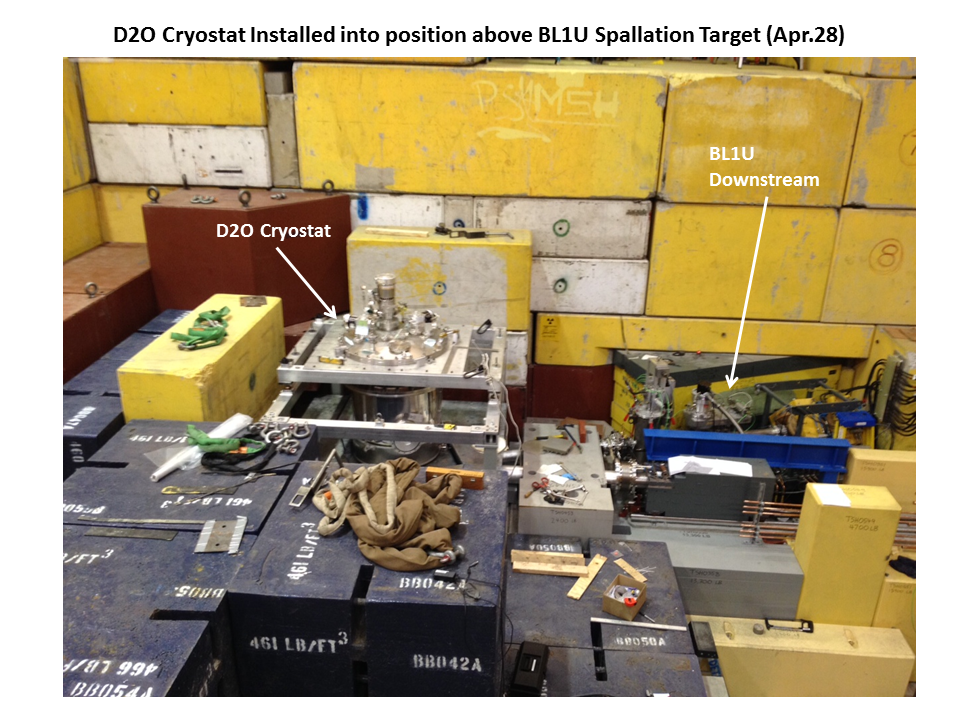
Tuesday, November 22, 2016 (Vancouver). PHOTO: Lori Rebenitsch (U. Winnipeg/U. Manitoba, left) and Tatsuya Kikawa (TRIUMF, right) insert samples for neutron irradiation. The residual activity of the samples will tell us how many neutrons we made, and their temperature.
Using a new method developed by Tatsuya and reported at the APS DNP meeting in October 2016, samples of exotic substances such as europium will be irradiated. These materials have the strange property that they capture cold neutrons differently than more commonly used samples such as gold. By comparing the europium and gold yields, we can therefore sense how cold our neutrons were. This is a critical step in understanding the thermalization of neutrons in our cold neutron moderator, which is made of solid heavy water (D2O).
How many neutrons do we make?
Tuesday, November 22, 2016 (Vancouver). PHOTO: Lori Rebenitsch (U. Winnipeg/U. Manitoba, left) and Tatsuya Kikawa (TRIUMF, right) insert samples for neutron irradiation. The residual activity of the samples will tell us how many neutrons we made, and their temperature.
Tuesday, November 22, 2016 (Vancouver). First proton beam was delivered down our new beamline to the spallation target. PHOTO: The celebration in the TRIUMF Main Control Room. This is the source of neutrons for our Ultracold Neutron Source.
In the future we will use the source to deliver ultracold neutrons to experiments on the fundamental properties of the neutron. Our flagship experiment will be an experiment to measure the electric dipole moment of the neutron. If we find it to be nonzero, it will signify a new source of CP violation, and could help in understanding the matter-antimatter asymmetry of the universe.
First beam for UCN
Tuesday, November 22, 2016 (Vancouver). First proton beam was delivered down our new beamline to the spallation target. PHOTO: The celebration in the TRIUMF Main Control Room. This is the source of neutrons for our Ultracold Neutron Source.


Ultracold neutron (UCN) news flash: The spallation target for the UCN source was installed last week, and now the first of the cryostats from Japan has been installed. Photo: (Upper) Jason Chak and Cam Marshall help the cryostat into place. (Lower) The D2O cryostat and the proton beamline after the cryostat was put in place.
The cryostat will contain solid heavy water (D2O) at 10 degrees above absolute zero. Neutrons produced in the spallation target will be cooled to around the same temperature as they bounce around in the heavy ice. At this point, they are referred to as cold neutrons. The cold neutrons will become ultracold by interacting with superfluid helium. To install the superfluid helium source is the next phase of the installation.
The D2O Cryostat is In!
Ultracold neutron (UCN) news flash: The spallation target for the UCN source was installed last week, and now the first of the cryostats from Japan has been installed. Photo: Jason Chak and Cam Marshall help the cryostat into place.

Former student Mark Abotossaway was featured on the front cover of "Winds of Change". Mark is now an aerospace engineer at Boeing, in Seattle, Washington.
Read the full story about Mark here:
http://www.nxtbook.com/nxtbooks/pohlyco/woc_2016spring/index.php#/2
Winds of Change magazine may be found here:
http://www.aises.org/news/woc
Abotossaway Featured
Former student Mark Abotossaway was featured on the front cover of "Winds of Change". Mark is now an aerospace engineer at Boeing, in Seattle, Washington.

Our colleague Akira Konaka (TRIUMF) has won the Vogt Medal, awarded by the Canadian Association of Physicists.
The Vogt Medal recognizes outstanding experimental or theoretical contributions to subatomic physics.
http://http://news-centre.uwinnipeg.ca/all-posts/uwinnipeg-congratulates-triumf-colleague/
http://www.triumf.ca/awards-honours/akira-konaka-awarded-2016-cap-triumf-vogt-medal
Konaka wins Vogt Medal
Our colleague Akira Konaka (TRIUMF) has won the Vogt Medal, awarded by the Canadian Association of Physicists. The Vogt Medal recognizes outstanding experimental or theoretical contributions to subatomic physics.
<< Previous 1 2 3 4 5 6 Next >>




